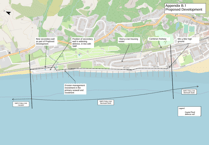The unemployment rate in Ceredigion and Gwynedd was lower than Wales' average last year, new figures show.
It comes as the UK jobless rate increased, with great disparities across regions.
New figures from the Office for National Statistics show some 1,400 (3.6 per cent) of the 38,076 economically active people in Ceredigion were unemployed in the year to June.
This was lower than the average across Wales where 4.1 per cent of adults able to work were unemployed, and slightly below the UK unemployment rate of 4 per cent.
The rate varied greatly across regions. The highest jobless rate stood at 5.5 per cent in London and the lowest at 1.9 per cent in Northern Ireland.
The unemployment rate in the UK increased from 3.7 per cent in the 12 months to June 2024.
Meanwhile the employment rate remained unchanged, at 75.4 per cent.
This figure also varied greatly across regions. The highest employment rate was recorded at 78.8 per centin the South West and the lowest at 70.3 per centin the North East.
In Ceredigion, 36,676 (72.2 per cent) of working-age people were in employment in the year to June. The figure was unavailable at source for Gwynedd.
The ONS said the statistics should be treated with caution as it continues to overhaul its labour market survey.
Joseph Evans, research fellow at the Institute for Public Policy Research, said: "It's a challenging market for jobseekers.
"Inactivity has dropped over the last year, meaning that more people are looking for work in a sign that the Government’s plan to 'Get Britain Working' is bearing fruit.
"But businesses are recruiting less as the economy continues to adjust post-pandemic, so competition for job listings is getting fiercer."
He added youth unemployment is increasing as "young people are finding it difficult to find work", calling on Chancellor Rachel Reeves "to get growth firing and investment flowing to ensure that everyone has good opportunities at the start of their career".
The ONS figures show 21.7 per centof the working-age population in Ceredigion was classed as 'economically inactive' in the 12 months to June.
Across the UK the figure stood at 21.3 per cent, slightly down from 21.6 per cent the previous year.
Economically inactive people are those not in work nor looking for work. They include students, retirees and carers for example.
Charlie McCurdy, economist at the Resolution Foundation, said: "While employment gaps across the UK have shrunk over the past decade, some regional labour markets are performing better than others.
"Over the past year, the number of payrolled employees has fallen throughout Britain, with only Northern Ireland recording a rise in employment.
"This poor performance has been most stark in the capital and has contributed to London having a higher unemployment rate than any other region of the UK."





Comments
This article has no comments yet. Be the first to leave a comment.